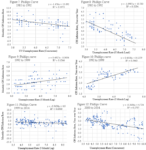Last week I posted something on how business confidence affects capital investment. Many factors may affect business confidence. The psychological mindset of business owners might change on its own. Public policies may affect business confidence too. Scholars at the University of Chicago developed an economic policy uncertainty index, which estimates our felt ambiguity regarding public policies1. The next graph depicts lagged effects of year over year changes in policy uncertainty on year on year changes in gross private domestic investment.As one might expect, higher levels of policy uncertainty correlate with lower levels of private investment (by 27%). Economic theory posits that fiscal and monetary policies work best when the public doesn’t know what to expect next.
Read More »2024-04-17



















